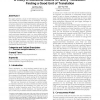Free Online Productivity Tools
i2Speak
i2Symbol
i2OCR
iTex2Img
iWeb2Print
iWeb2Shot
i2Type
iPdf2Split
iPdf2Merge
i2Bopomofo
i2Arabic
i2Style
i2Image
i2PDF
iLatex2Rtf
Sci2ools
SIGIR
2006
ACM
2006
ACM
A study of statistical models for query translation: finding a good unit of translation
This paper presents a study of three statistical query translation models that use different units of translation. We begin with a review of a word-based translation model that uses cooccurrence statistics for resolving translation ambiguities. The translation selection problem is then formulated under the framework of graphic model resorting to which the modeling assumptions and limitations of the co-occurrence model are discussed, and the research of finding better translation units is motivated. Then, two other models that use larger, linguistically motivated translation units (i.e., noun phrase and dependency triple) are presented. For each model, the modeling and training methods are described in detail. All query translation models are evaluated using TREC collections. Results show that larger translation units lead to more specific models that usually achieve better translation and cross-language information retrieval results. Categories and Subject Descriptors H.3.3 [Informati...
Related Content
| Added | 14 Jun 2010 |
| Updated | 14 Jun 2010 |
| Type | Conference |
| Year | 2006 |
| Where | SIGIR |
| Authors | Jianfeng Gao, Jian-Yun Nie |
Comments (0)

